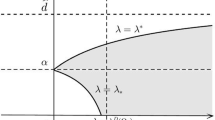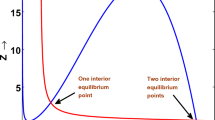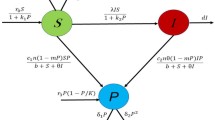Abstract
In this paper, we study a free boundary problem for a ratio-dependent predator–prey system in one space dimension, in which the free boundary is only caused by prey, representing the spreading fronts of prey. We discuss the long time behaviors of solution as \(t\rightarrow \infty \) and establish a spreading–vanishing dichotomy; namely, either the two species successfully spread to infinity as \(t\rightarrow \infty \) and survive in the new environment, or they cannot spread to the whole space and the prey will vanish eventually. Then, the criteria for spreading and vanishing are obtained. Furthermore, when spreading occurs, some estimates of the asymptotic speed of h(t) as \(t\rightarrow \infty \) are provided. Finally, some realistic and meaningful phenomena are discovered.
Similar content being viewed by others
References
Arditi, R., Ginzburg, L.R.: Coupling in predator-prey dynamics: ratio-dependence. J. Theor. Biol. 139(3), 311–326 (1989)
Arino, O., Mikram, J., Chattopadhyay, J.: Infection in prey population may act as a biological control in ratio-dependent predator-prey models. Nonlinearity 17(3), 1101–1116 (2004)
Aronson, D.G., Weinberger, H.F.: Nonlinear diffusion in population genetics, combustion, and nerve pulse propagation. Springer, Berlin Heidelberg (1975)
Bunting, G., Du, Y.H., Krakowski, K.: Spreading speed revisited: analysis of a free boundary model. Netw. Heterog. Media 7(4), 583–603 (2012)
Caffarelli, L., Salsa, S.: A geometric approach to free boundary problems. American Mathematical Society, 2005
Cantrell, R.S., Cosner, C.: Spatial ecology via reaction-diffusion equations. John Wiley and Sons, Led. (2004)
Chen, X.F., Friedman, A.: A free boundary problem arising in a model of wound healing. SIAM J. Math. Anal. 32(4), 778–800 (2000)
Crank, J.: Free and Moving Boundary Problems. Clarendon Press, 1984
Du, Y.H., Guo, Z.M.: Spreading-vanishing dichotomy in a diffusive logistic model with a free boundary, ii. J. Differ. Equ. 250(12), 4336–4366 (2011)
Du, Y.H., Guo, Z.M., Peng, R.: A diffusive logistic model with a free boundary in time-periodic environment. J. Funct. Anal. 265(9), 2089–2142 (2013)
Du, Y.H., Lin, Z.G.: Spreading-vanishing dichotomy in the diffusive logistic model with a free boundary. SIAM J. Math. Anal 42(1), 377–405 (2010)
Du, Y.H., Lin, Z.G.: The diffusive competition model with a free boundary: invasion of a superior or infetior competitor. Discr. Contin. Dyn. Syst. 19(10), 3105–3132 (2014)
Du, Y.H., Lou, B.D.: Spreading and vanishing in nonlinear diffusion problems with free boundaries. Mathematics 17(10), 2673–2724 (2015)
Hairston, N.G., Smith, F.E., Slobodkin, L.B.: Community structure, population control, and competition. Am. Nat. 94(879), 421–425 (1960)
Lin, G.: Spreading speeds of a Lotka-Volterra predator-prey system: the role of the predator. Nonlinear Anal. 74(7), 2448–2461 (2011)
Robert, F.L.: Evaluation of natural enemies for biological control: a behavioral approach. Trends Ecol. Evol. 5(6), 196–199 (1990)
Wang, J.P., Wang, M.X.: The diffusive Beddington-DeAngelis predator-prey model with nonlinear prey-taxis and free boundary. Math. Method. Appl. Sci. 41(16), 6741–6762 (2018)
Wang, M.X.: On some free boundary problems of the prey-predator model. J. Differ. Equ. 256(10), 3365–3394 (2014)
Wang, M.X.: Spreading and vanishing in the diffusive prey-predator model with a free boundary. Commun. Nonlinear Sci. Numer. Simul. 23(1–3), 311–327 (2015)
Wang, M.X., Zhang, Y.: Two kinds of free boundary problems for the diffusive prey-predator model. Nonlinear Anal. Real 2015(24), 73–82 (2015)
Wang, M.X., Zhang, Y.: Dynamics for a diffusive prey-predator model with different free boundaries. J. Differ. Equ. 264(5), 3527–3558 (2018)
Wang, M.X., Zhao, J.F.: Free boundary problems for a lotka-volterra competition system. J. Dyn. Differ. Equ. 26(3), 655–672 (2014)
Wang, M.X., Zhao, J.F.: A free boundary problem for the predator-prey model with double free boundaries. J. Dyn. Differ. Equ. 29(3), 957–979 (2017)
Wang, M.X., Zhao, Y.G.: A semilinear parabolic system with a free boundary. Z. Angew. Math. Phys. 66(6), 3309–3332 (2015)
Zeng, X.Z., Gu, Y.G.: Existence and the dynamical behaviors of the positive solutions for a ratio-dependent predator-prey system with the crowing term and the weak growth. J. Differ. Equ. 264(5), 3559–3595 (2018)
Zhang, W.Y., Liu, Z.H., Zhou, L.: A free boundary problem of a predator-prey model with a nonlocal reaction term. Z. Angew. Math. Phys. 72(2), 1–21 (2021)
Zhao, J.F., Wang, M.X.: A free boundary problem of a predator-prey model with higher dimension and heterogeneous environment. Nonlinear Anal. Real 2014(16), 250–263 (2014)
Zhao, Y., Liu, Z.H., Zhou, L.: Dynamics for a nonlocal reaction-diffusion population model with a free boundary. Acta. Appl. Math. 159, 139–168 (2019)
Zhao, Y.G., Wang, M.X.: A reaction-diffusion-advection equation with mixed and free boundary conditions. J. Dyn. Differ. Equ. 30, 743–777 (2015)
Zhou, L., Zhang, S., Liu, Z.H.: A free boundary problem of a predator-prey model with advection in heterogeneous environment. Appl. Math. Comput. 289, 22–36 (2016)
Acknowledgements
The author’s work was supported by the National Natural Science Foundation of China 12071316. The author would like to thank Professor Mingxin Wang who gave me invaluable lectures on free boundary. The author is also grateful for the anonymous reviewers for their helpful comments and suggestions.
Author information
Authors and Affiliations
Corresponding author
Ethics declarations
Conflict of interest
The authors declare that they have no conflict of interest.
Additional information
Publisher's Note
Springer Nature remains neutral with regard to jurisdictional claims in published maps and institutional affiliations.
Rights and permissions
Springer Nature or its licensor (e.g. a society or other partner) holds exclusive rights to this article under a publishing agreement with the author(s) or other rightsholder(s); author self-archiving of the accepted manuscript version of this article is solely governed by the terms of such publishing agreement and applicable law.
About this article
Cite this article
Liu, L., Yang, C. A free boundary problem for a ratio-dependent predator–prey system. Z. Angew. Math. Phys. 74, 69 (2023). https://doi.org/10.1007/s00033-023-01957-3
Received:
Revised:
Accepted:
Published:
DOI: https://doi.org/10.1007/s00033-023-01957-3




